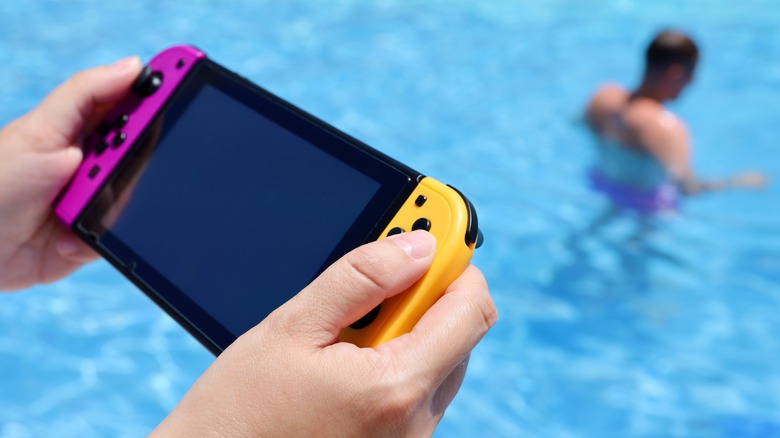This Is The First Thing You Need To Do If Your Nintendo Switch Is Water Damaged
The Nintendo Switch may be a hybrid home and handheld console, but even being half-handheld means it regularly gets subjected to the risks that face other handheld devices daily. If you take your Switch around with you on vacation, all it takes is one misstep or bumped elbow to drop the entire thing into a sink, bathtub, pool, or even just a puddle of water on the kitchen counter.
No matter what kind of body of water it's in, it doesn't change the fact that the Switch isn't meant to get wet. Due to the number of vents and openings on the Switch, there are a lot of spots that water could potentially creep into and wreck the console from the inside-out.
If your Switch is exposed to water, there are a few tricks you can try to attempt to salvage it. Just be prepared to accept defeat and send it off to Nintendo for repairs if you can't get it working again.
What you should do first
As soon as your Nintendo Switch has been exposed to water, the very first thing you need to do is immediately disconnect any external power sources like power cables or portable batteries. Electricity and water are a bad combination, so you need to cut off any external currents ASAP. If you were using the Switch in standalone handheld mode, that's actually a little better, since the only source of power is the internal battery, which is sealed.
Once you've disconnected the Switch from external power, you need to ensure it's fully powered down. Press and hold the power button on top of the Switch for three seconds. If the console is still working, the power menu should appear on screen, allowing you to turn it off completely with your controller. Remember, you need the Switch to be completely powered down, not just in sleep mode.
Cleaning and caring
After your Nintendo Switch has been completely isolated from external power sources and powered down, it's time to run damage control. The precise scope of your response will depend on exactly how much water your Switch was exposed to.
If you only got a bit of water splashed onto the Switch's external components, you can wipe it off with an absorbent microfiber cloth. If you're lucky, no water will have gotten into the vents, speakers, or other assorted crevices. If your Switch had a large amount of water dumped on it, or you the console was submerged in water to any degree, then you'll need to place it in a dry, clean space and leave it to air dry for at least a few days.
Whatever water got in there, it needs time to completely dry out and evaporate, and that can take a while. If you're really worried, you can try the old electronics maintenance hack and place your Switch into a bowl/bag of dry white rice. The rice will help to absorb any of the moisture hiding in the console, but it doesn't speed up the process, so you'll still need to leave it for several days.
Once you've given the Switch time to dry off, you can hold the power button again to attempt to boot it up. If it works, great, but if it doesn't, then you'll have to send it to Nintendo for repairs.
What you should not do
In the event that your Switch is exposed to water, there are several things you absolutely should not do during the post-care process. First and foremost, do not attempt to open the Switch's casing, even if you think water got into it. Opening the console, much like jailbreaking it, immediately voids the warranty — which means Nintendo won't repair it for you (at least, not for free).
Second, don't attempt to jostle or shake water out of the Switch. All this will do is help the water snake its way further into the console's internals, increasing the likelihood of damage. Third, never attempt to use heat to speed up the drying process. Do not use a blow-dryer or radiator to make the water evaporate faster, as these methods will just overheat the Switch and ensure damage.
Finally, do not plug your Switch back into any electrical sources, including its dock, until you are absolutely certain the water has been removed. If there's any loose water left in there, you could cause an electrical surge.



